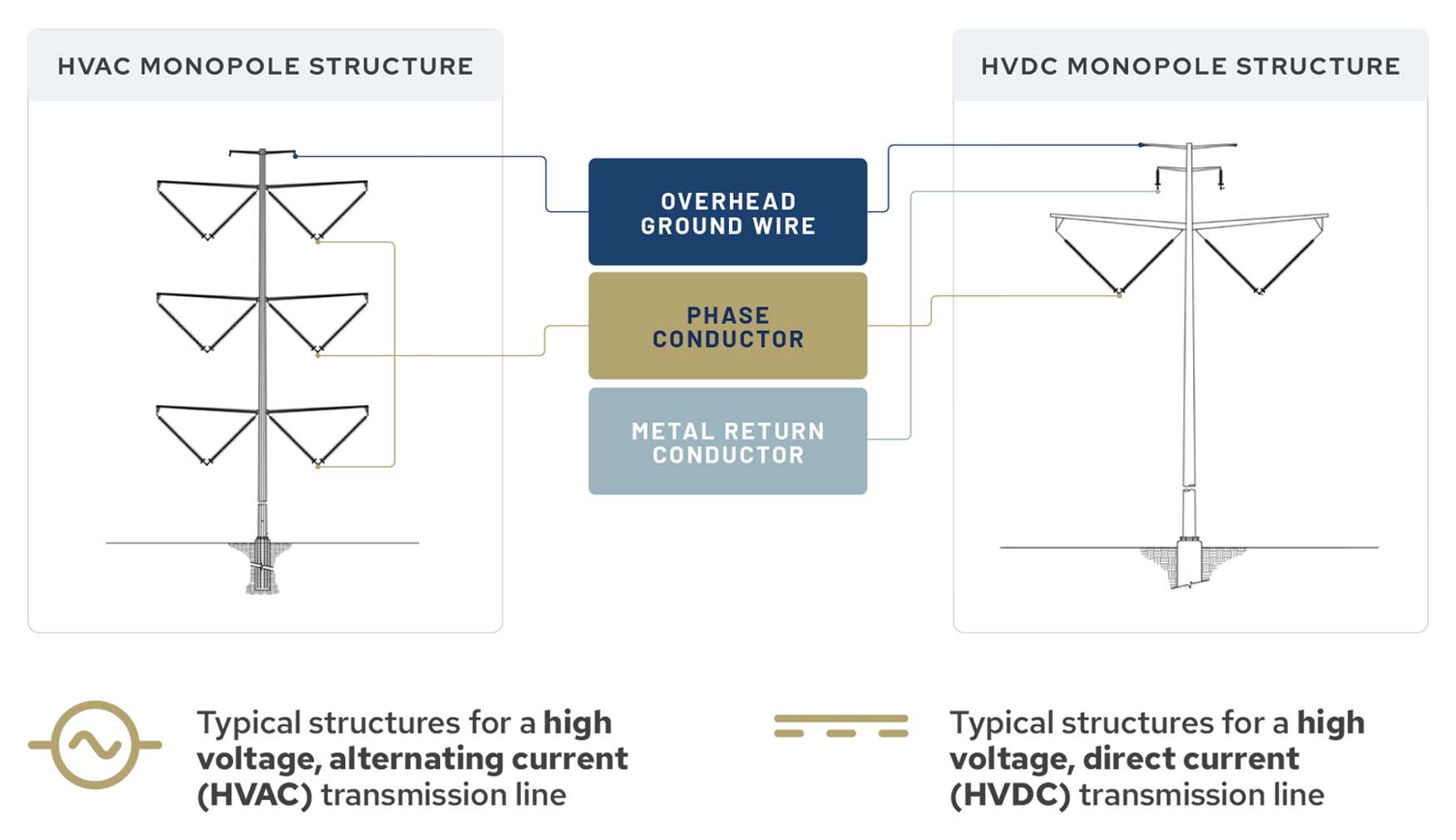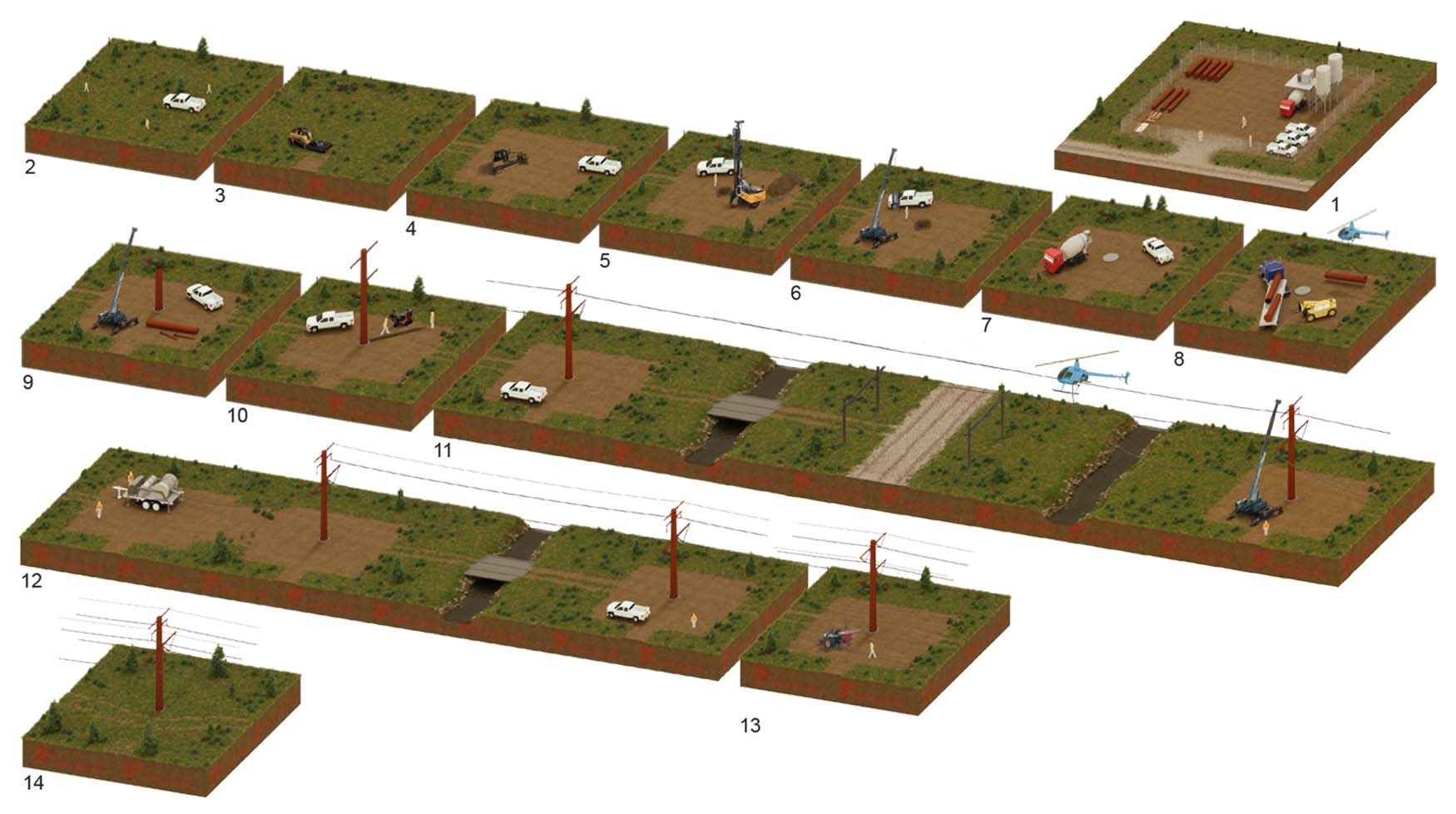General FAQ
Grid United, an independent transmission company, is developing the North Plains Connector. Grid United’s mission is to modernize our power grid to create a more resilient and efficient electric system that takes advantage of the nation’s abundant and geographically dispersed natural resources to the benefit of all consumers. The Grid United team is comprised of energy professionals with extensive experience in developing, designing, permitting, and constructing large-scale linear infrastructure across North America.
The North Plains Connector will be an approximately 415-mile-long transmission line, extending from an existing substation in Colstrip, Montana, to an existing substation in Center, North Dakota, and to a new substation in Morton County, North Dakota. The route is still being developed and will not be finalized until input has been received from landowners, communities, and local, state and federal government officials.
The project will incorporate feedback and survey data before submitting a route for regulatory approval. The project route is considered “proposed” until it has been approved by state and federal regulatory bodies.
Yes, as well as private lands.
By utilizing direct current (DC) technology, electricity can be sent in either direction, east or west. The North Plains Connector will transport electricity when and where it is needed. It can serve to balance the electricity needs in the Western and Eastern Interconnect grids.
Community members and stakeholders along the route can meet with the North Plains Connector team individually and at community meetings.
Construction and maintenance of the towers and converter sites require a combination of temporary and permanent access roads. These roads will be identified during the landowner consultation phase, and landowners with access roads on their property will be compensated accordingly.
Construction crews will make an effort to access the right-of-way from public roads that intersect or are adjacent to the right-of-way. Once an access road is established, construction will follow the right-of-way to the next access road location, which will preferably be located at the next public road crossing. In some instances, depending on topography or other environmental conditions, off-right-of-way access may be needed to facilitate the construction or maintenance of the line.
The North Plains Connector will be open to all sources of electrical power generation. Regulations governing the grid require the project to carry electricity without preference for any technology.
By connecting the two largest electrical grids in the United States, the North Plains Connector will support a more resilient, reliable, and efficient electric system that takes advantage of the nation’s abundant, geographically dispersed natural resources to benefit all consumers.
Numerous studies by the U.S. Department of Energy (DOE) and other government and non-governmental organizations have demonstrated a need for high voltage direct current transmission lines like the North Plains Connector.
The North Plains Connector is expected to be owned, operated, and maintained by local utilities.
While the design life of a DC converter station is typically 40 years, the operational existence of existing DC lines reveals that they are operated safely and reliably well beyond this standard time frame.
For example, the Pacific DC Intertie has been functioning successfully (with the appropriate upgrades and maintenance) since 1970 and is still in operation.
Landowners
You agree to allow the North Plains Connector team access to conduct various ground surveys on your property. Surveys may include staking of the proposed route and boundaries as well as surveys that collect important geological, biological, and cultural information.
Yes, landowners will be compensated for granting survey permission to the North Plains Connector team.
Ground surveys began in 2022 and will continue through 2024. The Project will attempt to minimize impacts to properties by consolidating survey activities, but it is not uncommon for projects of this nature to require survey access on more than one occasion.
A North Plains Connector land agent will work with individual landowners to reach agreement on an Option for Easement (Option). The Option grants NPC the right, but not the obligation, to obtain an Easement Agreement (Easement) for electric transmission purposes across your property.
The Option lays out the terms of the agreement between North Plains Connector and the landowner. It includes the compensation that the landowner will receive for the Option, an approximated sketch of the easement area, the form of the Easement that will be used if North Plains Connector exercises its option, and other terms.
The Easement is the document that lays out North Plains Connector’s rights and its obligations with respect to the construction and operation of the Project on a landowner’s land. It includes details regarding the right-of-way and North Plains Connector’s obligations to restore the areas affected by construction. It also addresses practical issues, such as the installation of temporary fencing to protect livestock during construction.
Yes. North Plains Connector is committed to working with landowners throughout the process to address landowners’ needs. The North Plains Connector land agents will work with landowners to understand those needs and incorporate appropriate terms into the Option and/or Easement.
Construction/Reclamation
We anticipate three to six structures per mile, with 900 to 1,600 feet between each structure. Structure height will typically range from 110 to 160 feet. The exact height depends on variables such as engineering requirements and topography. Structures could exceed 160 feet—but not 195 feet—in rare instances that require longer spans, such as river crossings, existing transmission line crossings, or very complex terrain.
Construction typically involves the following:
- Site Preparation: Clearing tower locations, laydown yards, and staging areas of vegetation and upgrading access roads
- Foundation Construction: Installing concrete foundations to anchor the transmission structures
- Structure Construction: Assembling the transmission structures from the ground up
- Wire-Stringing Operations: Stringing the conductor from structure to structure, attaching to the insulators on each structure for the entire length of the route
- Restoration: Upon construction completion, cleaning and restoring the right-of-way to pre-construction condition
Construction for the North Plains Connector will take approximately three years. Certain land use practices will be restricted while construction is taking place on your land such as excavations or topographic changes. When construction is complete, we will restore the easement area to its original condition and appearance, at which point landowners can resume normal use with a few exceptions, laid out in the executed Easement Agreement.
The North Plains Connector team has developed a construction, mitigation, and reclamation plan that includes weed control procedures. The methods for weed control will be reviewed during the permitting process and will be approved by the state regulatory agencies in coordination with the county officials and landowners.
Yes. All topsoil, up to 12 inches or the depth of cultivation, whichever is greater, will be stripped and segregated.
Reseeding will occur in compliance with the Natural Resources Conservation Service (NRCS). Landowners will have the option to provide a specified seed mix.
Permitting
Federal Review:
- The project will be reviewed under the National Environmental Policy Act (NEPA) in connection with its funding and routing process across federal lands. The lead federal agency (i.e., the US Department of Energy) will oversee the NEPA review, in coordination with other federal agencies.
- Federal Energy Regulatory Commission (FERC) approval is required, along with that of the FERC-approved Regional Transmission Organizations (RTOs) including the Midcontinent Independent System Operator (MISO) and the Southwest Power Pool (SPP).
Other:
- The North Plains Connector will comply with any applicable local ordinances, including county approvals.
- Tribal Nations with cultural or historic interests in the project area are consulted for approval throughout the development process.
- Wetland and waterbody surveys
- General habitat mapping
- U.S. Forest Service plant surveys
- Dakota Skipper Reproductive and Foraging Habitat surveys
- The state and federal permitting processes will identify the social, economic, and environmental impacts attributable to the construction and operation of the project. The North Plains Connector seeks to minimize impacts to the built and natural environment through agency, local and tribal consultation, resource surveys, and expert planning.
Tribal Nations
The North Plains Connector involves Tribal Nations early during the development process and takes an inclusive view of Tribal Nations’ rights, including working to understand the spectrum of place-based interests of Tribal Nations.
We respect the Tribal Nations as a sovereign whole, and as such recognize the contemporary and historical boundaries of the many Tribal Nations in the Northern Plains and Rocky Mountains area, regardless of territory. Tribal Nations understand that the North Plains Connector knows there is more than one community and that it respects the sovereignty and self-determination of Tribal Nations over their land, people, and resources.
The North Plains Connector is actively working with 21 Tribal Nations in cultural survey and other pre-application design phases of the transmission line. Additionally, the North Plains Connector has engaged Tribal Nations beyond the project area region, inviting their involvement in project development and respecting sovereign decisions to withhold from project participation.
The North Plains Connector is working with potential construction and operation partners to ensure the continued involvement of Tribal Nations.
The North Plains Connector is working in the pre-National Environmental Policy Act (i.e., federal permitting) application design phase of the development process with Tribal Nation colleges to address operations and maintenance needs for the project after construction is complete.
The North Plains Connector has been sited to avoid and minimize waterbody crossings to the extent practicable. The project will cross both flowing waters, such as streams and rivers, and non-flowing waters, including lakes and ponds, in both North Dakota and Montana. The majority of waterbodies crossed are intermittent streams. Some waterbodies crossed include the Tongue and Powder Rivers in Montana and the Heart, Cannonball, and Little Missouri Rivers in North Dakota.
The North Plains Connector proposes to install best management practices to prevent impacts to stream flow, wetland fill, and water quality impacts. Best management practices include waterbody crossing avoidance, properly sized culverts, low water body crossings, and construction matting, among others.
Information collected by the North Plains Connector is subject to the data sovereignty and digital jurisdiction of Tribal Nations.
The North Plains Connector currently engages with the Youth Treaty Council and is open to opportunities as they arise to partner with Tribal Nations. Through the North Plains Connector Community Investment Program, non-profits and community organizations that are part of Tribal Nations near the project area are eligible to apply for grants up to $50,000 per award cycle. Click here for more information.


